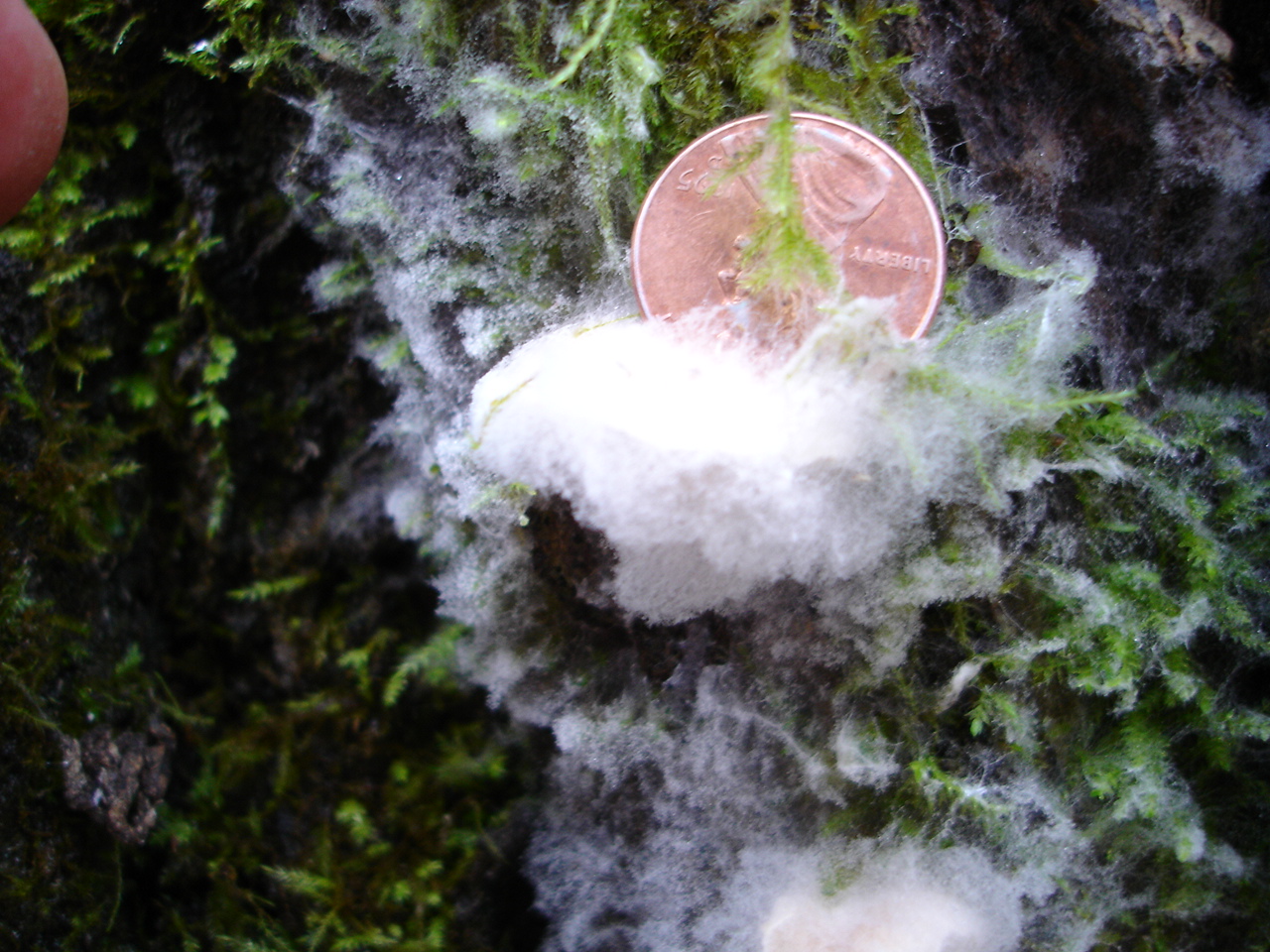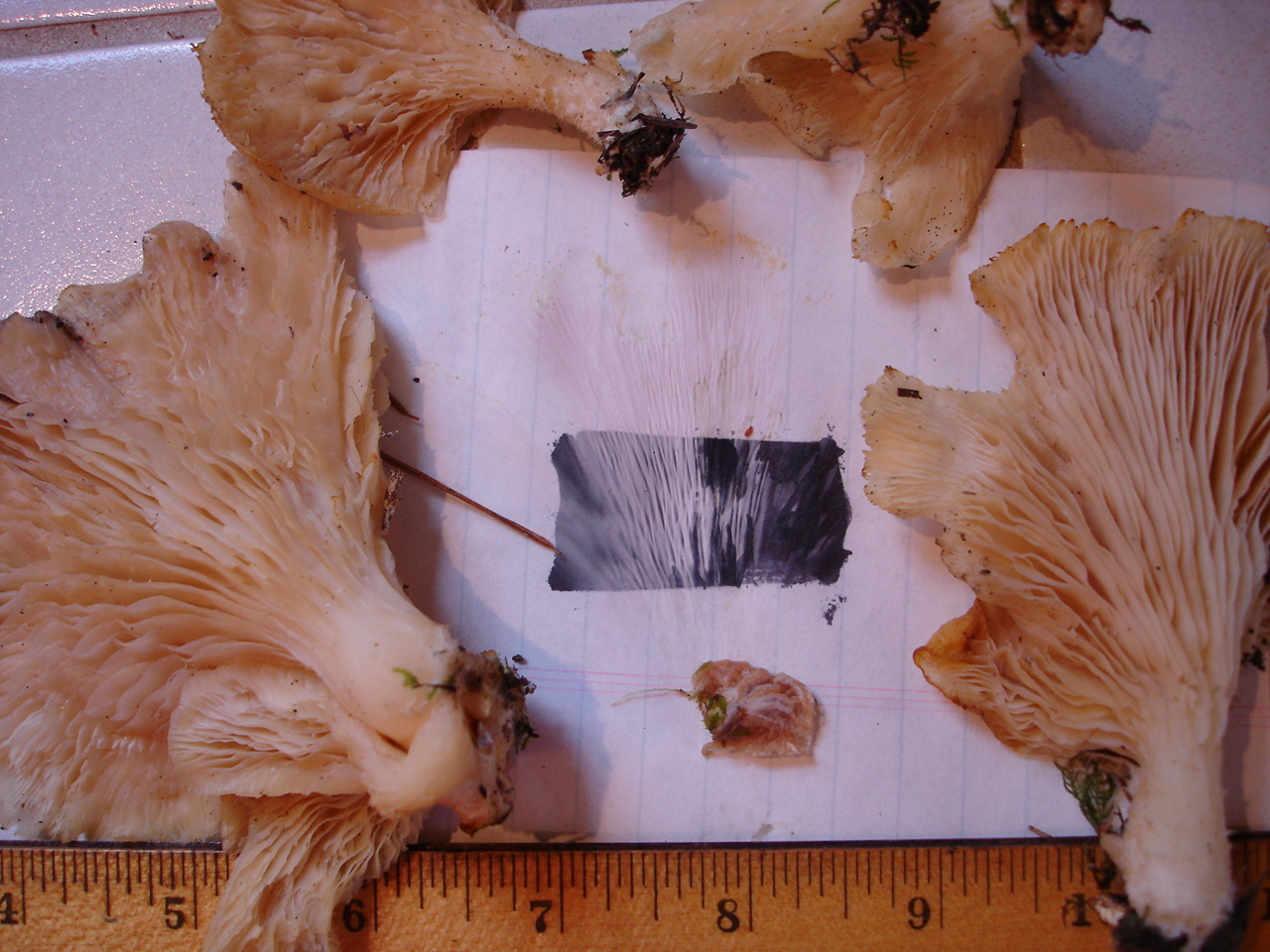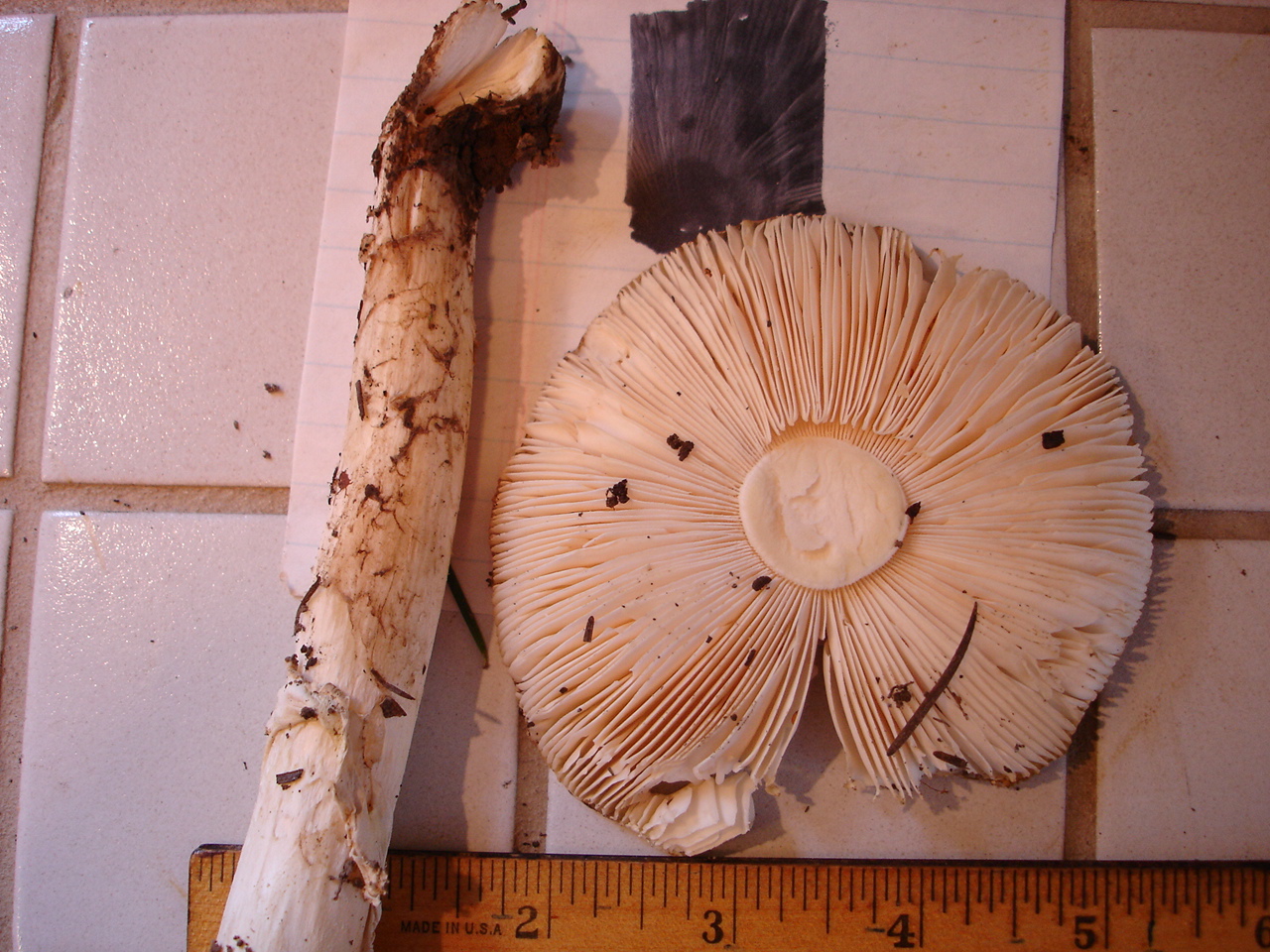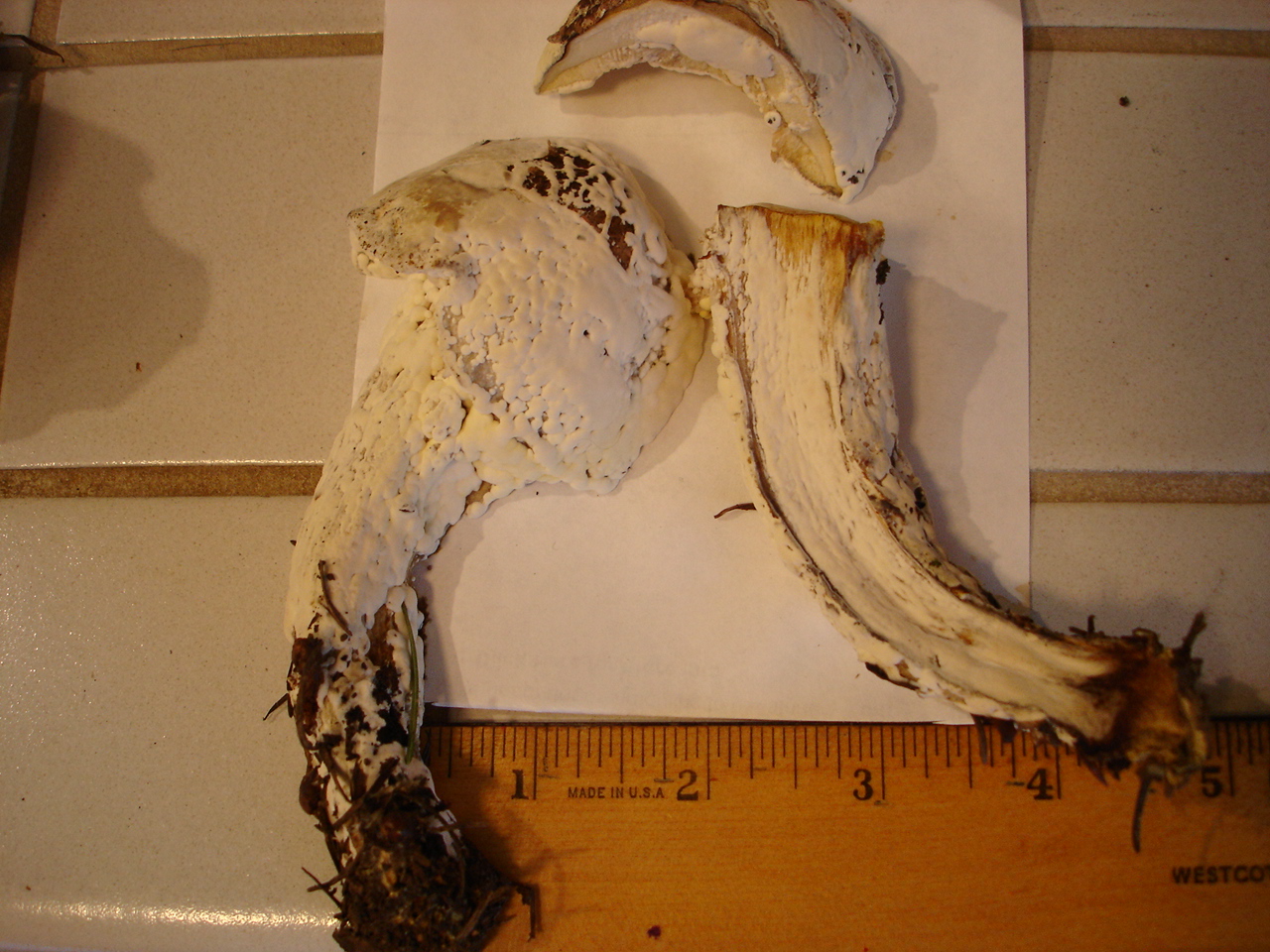A variety of mushrooms
Posted by Paul 12/12/12 - - - - - -Scroll Down to See the Discussion
Image 002

Image 005

Image 006

Image 008

Image Yard 2012 008
.jpg)
Paul: I’m still at it. I figure I can learn a few more genera before it freezes.
Yard 2012 008 – Dick kindly showed me the way to guessing Serpula lacrymans or Dry Rot Fungus.
Question: Are the underside maze of flesh what one calls “subgills”?
002 – This little one covered in a mycelial? web caught my eye.
It appears kind of ethereal. Closer examination at home indicates the mushroom under
the web may be Marasimius as seen on pic 005 just below the black rectangle.
Question: Any idea what the web is?
005 – Hopefully this is a Pleurotus.
Dick was concerned about the long stipe but some individuals have short ones
and some long ones all from the same log.
006 – Once again – at a loss.
The spore print is definitely white to lite buff and there is a prominent veil.
There is no volva. The gills are kinda weird in that they vary from adnate to seceding.
The stipe breaks like chalk but do any Russulas have veils?
008 – This one interested me because about a dozen mushrooms around a live cedar
all had this white powder covering.
Question: is the white powder likely Hypomyces?
Sava: If you still have 006 with you, please describe what the cap surface looks like.
Is it sticky perhaps?
What was it growing on; was there only one?
It is not a Russula (presence of ring, stem too slender, ...).
The material on the stem surface below the ring makes me wonder if this might be a Limacella,
a rare genus here. Let's find out.
Paul: I saved the specimen and will continue to do so incase you want a picture.
I should have turned the cap over for another picture….
There was only one growing in the duff of the forest floor.
The forest is a second or third growth mixed conifer / deciduous.
I found several shrimp russula in this area a few weeks ago.
The cap has about a 16th of an inch of what appear to be veil remnants around the edge.
The central two inches of the cap have a thin layer of warts
(closely nested versus widely nested as in Amanita) that feel like suede.
The outer ¾ of an inch of the cap is suede-like dry and oily when wetted.
I would not describe it as sticky.
Sava: Please do take a photo or two of the cap surface that show the important details you noticed there.
Can we also try the test "does stem separate cleanly from the cap"?
It may be a little difficult now because the part of the stem that's still attached to the cap is very short.
(This fact may be an indication that the stem does not break cleanly from the cap, but let’s see.) Cut the cup and the part of stem attached to it in halves, through the center of the stem. Use one of the halves and try to remove the part of the stem that’s there from the cap. Is there a clean separation line there between the cap and stem?
A photo of this scene would be good too.
Paul: Here are a couple of pictures that you requested.
The outer edge of the cap seems to have veil remnants
Note the inner circle of thin warts. I suspect the warts are also veil remnants.
The outer surface of the cap was slick not viscid/sticky.
The remaining piece of stipe on the cap did not break away easily.
The coloration of the stipe is different from the cap.
I inserted a blade between the end of the stipe and the cap to encourage the break away.
The stipe did not break away easily.
The stipe and cap finally separated along the cut but pulled a section of gills with it.
The veil remnant on the stipe was very noticeable (i.e., ½ inch wide) when picked.
The veil had collapsed onto the stipe by the time I took the picture.
I’ll be interested to hear your ideas.
.jpg)
.jpg)
Judy: The material on the cap should be a good tip-off to you for leading the the correct genus.
What other common mushrooms do you recognize that have these discreet white patches?
If you can scrape them off, leaving the skin underneath complete, they are not scales,
but what? And because nature is not always consistent, but has subtle variations,
remember that sometimes caps and stems to not always break away easily,
despite what the keys may use as a determining factor for a genus.
Did you collect the entire fungus, including the base of the stem? Was there anything left in the soil?
Have fun tracing these clues.
Judy: I suspect you are leading me towards Amanita but there was NO volva.
I did dig extra deep in the duff to get the entire base of the stipe (see picture).
The specimen is now soooo soft and mushy that I can’t scrape the “warts”
(i.e., discrete patches) off the cap. So no help there….
Sorry to appear dense but I am still at a loss.
Judy: The cap patches say it is an Amanita,
and our region has no other genus with that character of those broken whitish patches,
and the volva on this particular species is a small,
tight little cup that adheres to the base of the stipe, and collapses easily.
When weather is this soggy, it can lose its little rim and collapse or disappear.
The cap surface had been yellow is presume?
Maybe whitish when you found it as the pigments are quite water soluble.
When weather is this wet and also this late in the season,
many mushrooms don’t have the classic features pictured or described in the keys.
This genus also has fragile, slightly inflated hyphae so they are particularly vulnerable
to collapse of vital characters.
A dissecting scope or good hand lens aimed at the base of the stipe will show
some of the volva characters (I enlarged your photo and can see a very thin layer
on the outside of the stipe base which is a remnant of the cup on the left side of the photo.)
Look at the drawings in Arora’s MDM on p. 264, there are two with collar-like or indistinct volvas,
and on p. 281, read the volva descriptions for A. gemmata
to see what I’m talking about.
Your mushroom belongs in this group –
there are several species that are very similar and not too well described or differentiated yet.
Some Amanitas tend to hybridize and they are a frustration to those of us who like to tell them apart.
So you are not missing anything – you just have to see lots of them and keep trying!
You will soon start seeing the obscure details that drive us all nuts.
Paul: Thanks Judy. The indistinct volva is news to me.
Its nice to be learning so much.
Had I known about the indistinct feature,
perhaps I would have cut the base in two pieces and looked for the veil remnants in the cross section?
Dick B: 005: note the lilac tint or the spores which is one of colors reported for the
Pleurotus ostreatus group. Others may range from white to yellowish to buff.
Also note how the tint of the spores can easily be told on white paper versus on black paper.
008: Most likely the first of three stages of Hypomyces chyrsospermus
which commonly attacks boletes such as B. chrysenteron and B. zelleri.
The second stage is yellow and the third seldom seen stage is red brown.
Yard 2012 008: Subgills are gills that originate at the cap margin
but do not extend all the way to the stipe.
They may be very short or extend almost all the way.
There will usually be 1 to 3 between each gill in species that have them.
Check out color plate 45 in MD for a good illustration of subgills.
Paul: Thanks for the info on Hypomyces.
I find it interesting that sexual reproduction occurs in the asci above ground and
only after going through several “phases”.
While I could say “ascomycetes”,
I am just starting to get the difference between basidiomycetes.
It’s a long and windy road between warm-blooded small mammals and the ascomycetes
that the mice eat :^)
OK if the Marasmius have sub gills, what does one call the mis-mash-mosaic of porey-gills
in the dryrot fungus?




.jpg)




.jpg)
.jpg)
.jpg)